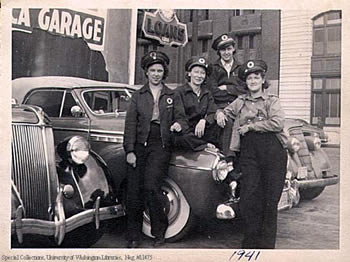
Lesson Twenty: Modern Society in the Pacific Northwest;
The Second World War as Turning Point
Women and Work: World War II was a special turning point for women, as these Texaco attendants shown in a 1941 photograph document. (Special Collections, University of Washington, Social Issues Files Ga. neg. #11475)
The previous lesson argues that a series of national crises between 1929 and 1989—in particular the Great Depression, Second World War, and Cold War—wrought thorough transformations that ushered in the modern Pacific Northwest. The crises interacted with one another to generate some of the same effects, e.g. an increased presence of Uncle Sam in the region, the restructuring of the economy so that it ultimately depended less than before on extractive industry, and heightened migration to Idaho, Oregon, and Washington. It is useful to stand back and conceive of these three crises working together to change the Pacific Northwest, to consider the six decades from 1929 to 1989 as something of a discrete era.
While lumping the crises of 1929-1989 together, however, two things should be kept in mind. First, it is important to realize that not all places within the region were affected in the same way by these events. Recall, for instance, that Oregon's and Washington's politics diverged during the 1930s, and that Wenatchee and Portland gained differently from dams on the Columbia River. The years since 1929 were generally prosperous ones for the urban Northwest, moreover, but rural parts of the region seldom benefited as much. Second, it is important to keep in mind that each national crisis had its own character and impact. The Great Depression was a time of economic hardship and doubt. It introduced more federal spending in the region, but the presence of the U.S. government was less substantial than it would be during the Second World War and Cold War. New Deal reformers envisioned large-scale changes in the region, but government lacked the resources to implement their plans fully until the post-war era. Finally, the Great Depression was perceived and dealt with largely as a domestic crisis; it seemed to have fewer international ramifications. The Cold War, by contrast, was a more protracted crisis that occurred in a time of greater economic abundance and that involved America and the Northwest in new ways with other peoples around the globe. The Cold War reshaped both the Pacific Northwest's economy (it secured an immense future for Boeing and Hanford in Washington, for example) and its politics (again, the McCarthyism of the period was especially pronounced in Washington state). In recent years people have agreed that the Cold War is "over," but its many effects linger on in the region.
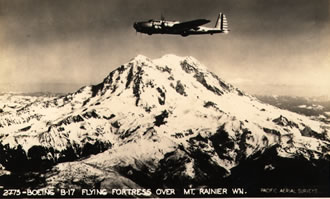
Of the three crises between 1929 and 1989, the Second World War exerted the greatest impact in the shortest span of time. I don't think it is appropriate to set the war years (1939-45) off by themselves, because they continued some trends already under way during the 1930s (the growth of a federal presence, migration of population from other states) and because the mobilization that they entailed was essentially perpetuated for more than four decades by the Cold War. Yet, World War Two is the single factor that I would point to if asked to account for how the Pacific Northwest became "modernized" during the 20th century. century. The war, more than any other event, deserves to be called a turning point in the regional history of the 20th century. As Carlos Schwantes explains quite nicely in The Pacific Northwest: An Interpretive History (chapter. 19), the Second World War resulted in profound transformations to the economy, society, and politics of the region. [Schwantes has also edited a nice anthology, The Pacific Northwest in World War II (Manhattan, KS: Sunflower University Press, 1986) on the region's wartime history.]
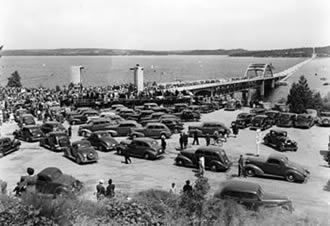 Above: A Boeing B-17 Flying Fortress over Mt. Rainier. (Special Collections, University of Washington, Postcard Files. Photo by Pacific Aerial Surveys.)
Above: A Boeing B-17 Flying Fortress over Mt. Rainier. (Special Collections, University of Washington, Postcard Files. Photo by Pacific Aerial Surveys.)
The New Deal brought many projects to Puget Sound that had long-term impacts on the future growth and development of the area. The Lake Washington Floating Bridge, (right) shown here during its dedication, the Tacoma Narrows Bridge, and McChord Field (now McChord Air Force Base), located north of Fort Lewis in Pierce County, were all dedicated the last week of June/July in 1940. This photograph was taken on July 2, 1940. (Asahel Curtis, negative 65146; copy negative. Special Collections, University of Washington. Original, Washington State Historical Society, Tacoma)
This lesson and the two to follow will explore the ways that the Second World War represented a turning point for Pacific Northwest society. That is, they focus on how the many different groups in the Pacific Northwest, particularly women and people of color, were affected by the war and the numerous events related to the war, and how the war years of 1939-1945 initiated a series of changes with long-term implications for the development of the region through the remainder of the 20th century. To understand these changes, particularly in regard to people of color, one needs to consider the Northwest experience prior to war. Lesson 21 and 22 will focus on African Americans and Asian Americans, respectively, in the 20th-century region; for both groups, the Second World War marked a crucial turning point. The remainder of this lesson will consider more generally how the war years initiated changes in the Pacific Northwest, and survey selected groups' experiences.
One way to appreciate the impact of World War Two on the Pacific Northwest is to look at basic census data. In the period between 1940 and 1990, both the total population and the numbers of minorities in the population increased substantially. (The main exception to this pattern, of course, was the reduced population of people of Japanese descent during the 1940s, due to the effects of wartime internment and relocation.) The war itself jump-started the demographic changes, as is evident in the changes between 1940 and 1950, and other events kept them going. As the following table shows, Washington consistently possessed a larger and more diverse population than Oregon or Idaho.
|
|||||||||||||||||||||||||||||||||||||||||||||||||||||||||||||||||||||||||||||||||||||||||||||||||||||||||||
It is useful to consider these regional data against national figures. The 1990 population of the Northwestern states was not as "diverse" as that of the rest of the country, largely because they had fewer Latinos and African Americans. But states in the region tended to have a relatively large proportions of Asian Americans and Native peoples in their populations.
|
These two tables show that the demographic mix of the Pacific Northwest became more complex during and after the Second World War. Because of the migration of people stimulated by the war and other events, the society of the Pacific Northwest became considerably less homogeneous in racial terms, and began to look more like the society of the rest of the United States. Like railroads and the New Deal, the Second World War helped to incorporate Oregon, Washington, and Idaho more closely into the United States. However, the location of the region remained important in keeping it from approximating the national average more closely. The Northwest remained relatively distant from main sources of African-American and Latino migration around and to the United States, for instance, so it had fewer black and Hispanic-origin residents than most states. The region was closer, too, to centers of Asian, Pacific Islander, and Native American populations, and Washington actually led most other states in those parts of its demographic makeup. The Pacific Northwest remained distinctive demographically, even as it resembled more than before the other states of the union. |
|||||||||||||||||||||||||||||||||||||||||||||||||||||||||||||
While the Second World War was not the only event contributing to a new demographic mixture in the Northwest between 1940 and 1990, it launched fundamental changes reshaping the regional population. These changes began to lower the geographic hurdles that had for so long inhibited migration to the region. In mobilizing for war, the United States needed to recruit people to serve in the armed forces and work in war-related industries. Moreover, because a large part of the war took place around the Pacific Rim, the government especially needed to mobilize the Pacific Coast. The western states became places from which troops and supplies would be shipped to the Pacific Theater of operations. The number of military bases and personnel there climbed dramatically. Many families followed servicemen out to the coast, as they prepared to leave for the Pacific front, and those families added to the region's wartime population. Simultaneously, the western states developed more industry to support the war effort, producing such things as warships and planes. The fact that Grand Coulee and Bonneville Dams had recently been completed on the Columbia River gave the Pacific Northwest extra appeal for manufacturing, because their surplus hydroelectricity was available to supply wartime industries. These businesses, too, demanded workers, who had to be recruited from all parts of the country. Additionally, the armed services and war-related manufacturing drew labor from other sectors of the economy; farms throughout the Northwest, for example, experienced shortages of workers, especially during harvests. Replacements needed to be recruited there, too.
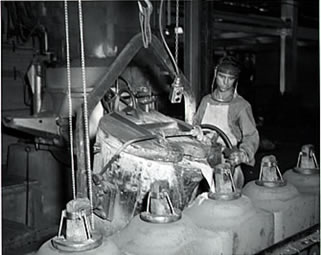
The Second World War reversed the economic conditions that had prevailed just a few years before. A depressed economy became a booming one; a surplus of labor turned into a shortage. By itself, the Northwest did not contain enough people to work in the burgeoning industries. Consequently, the federal government and private sector both undertook large-scale efforts to recruit workers to Washington, Oregon, and Idaho. This effort laid the foundation for the diversification of the regional population that occurred between 1940 and 1990. African Americans came to the Northwest during the war to work in shipyards and airplane factories in Portland and Seattle; Latinos came to work on farms and ranches; Indians left reservations in substantial numbers to work in cities and enlist in the armed services. Moreover, many people of all colors moved to or through the Northwest, including in particular people from Midwest and the western fringes of the South—Arkansas, Oklahoma, Texas, and Louisiana. Not all migrants stayed in the Northwest for the duration of the war; most went "home" once the war ended. But many stayed and made a life in the region, and others who had passed through the area during the war liked what they saw and returned months or years later to live in the Northwest. In these ways the Second World War precipitated broad demographic changes. The population of the region expanded as well as became more diverse.

Above, right: The Aluminum Industry. Among the many industries drawn to the Pacific Northwest by the abundance of hydroelectricity was the production of aluminum. This view shows the pouring of molten aluminum around a steel slab in the carbon anodes used in the smelting of aluminum at a plant near Wenatchee. Other World War II Pacific Northwest Plants were located at Longview and Tacoma in Washington State, and near Salem in Oregon. (Special Collections Division, University of Washington Libraries, neg. #16866. Photograph courtesy Aluminum Company of America, Wenatchee.)
Right: The Kaiser Company's shipyard in Portland, Oregon was one of the many wartime industries that drew people into the Pacific Northwest. This symbol was originally reproduced in "The Yard" section of The Bo's'n's Whistle, a publication put out by the Oregon Shipbuilding Corporation, the Kaiser subsidiary in Oregon. (Courtesy of the Kaiser Corporation. Reproduced in Manley Maben, Vanport. Portland, 1987. Title page.)
Below: Richland, Washington, looking west. (Special Collections, University of Washington Libraries, Nell Lewis MacGregor papers, box 1. Photograph by Robley L. Johnson.)
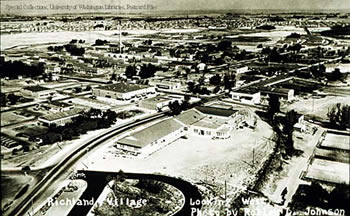
The construction of the Hanford Engineer Works, which manufactured plutonium for atomic bombs, illustrated the demographic patterns. The population in and around the towns of Pasco, Kennewick, and Richland hovered around 7,000 or so in 1940. But the construction of the Hanford plant required a work force that reached 45,000 at its peak, and many of these workers brought family members with them. After construction ended, more than 15,000 additional newcomers remained behind in Richland to operate the plant, while the towns of Kennewick and Pasco underwent dramatic population increases during wartime, too. The Army and the Du Pont company recruited workers from every state of the union to work at Hanford—and because the living conditions seemed so harsh, recruiters had to work overtime to make up for the high rate of employee turnover on the job. Non-whites comprised 16.5% of the construction workforce at Hanford, where they were housed and fed in segregated facilities. African-Americans made up the largest non-white group on the site; Mexican-Americans were recruited later, and housed at a separate, distant site on the edge of Pasco. Many longer-term, white residents of Washington reacted to Hanford's employment patterns with suspicion or resentment. The plant siphoned off laborers from nearby farms, and it raised questions as to the fate of the newcomers once the war ended. Washington Governor Arthur Langlie urged the ranking officer at Hanford to arrange, once work was completed, "to return most of the construction workmen back to their original centers of activity, particularly the negroes." Most workers and their families did leave when the plant was finished, but Hanford remained open for business and by 1950 it supported an urban area, the Tri-Cities, with a diverse population of more than 42,000, about six times as many people as had resided in the vicinity ten years before. Unlike the temporary work force, the plant and the nearby towns (not to mention radioactive wastes) remained behind after the war and grew into an important part of modern Washington.
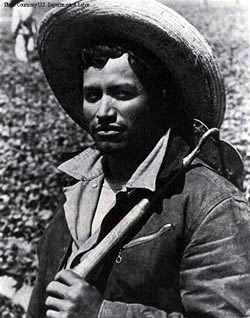
Population growth and diversification resulted from other factors, too. The Second World War marked a turning point nationally in terms of American immigration policy. The nation slowly began modifying the restrictions it had placed on the entry of foreigners to the country between 1882 and 1924. The main reforms would occur long after the war itself, particularly with the immigration act of 1965, but the steps taken during the war were notable and had an immediate impact upon the Pacific Northwest. In 1943 the United States eased its restriction on Chinese immigration, largely because it was allied with China in the war against Japan. And in 1942 the nation signed a treaty with Mexico providing for the importation of seasonal farm workers, known as braceros. The first such laborers arrived in Washington in October 1942, and more came in following years. Over the course of the war, Washington received 6% of all braceros in the U.S., Idaho got 5%, and Oregon 4% (many more headed to Texas and California). The bracero program lasted, with interruptions, until 1964. Farmers also actively recruited Chicanos (people of Mexican descent who already resided in the U.S.) to the Northwest as well during the war. These influxes increased the region's Latino population considerably. They were particularly welcomed in the Yakima Valley of Washington, where growers had faced such labor shortages during the hop harvest in 1941 that they had actually succeeded in closing public schools for a week to ensure that the harvest got in. At the end of the 1943 harvest, the Yakima Chamber of Commerce sent a letter of thanks for the braceros to the President of Mexico. Braceros were meant to be seasonal workers, but the enlarged presence of people of Mexican descent, especially in Yakima, Benton, Franklin, Grant, Chelan, and Walla Walla counties, was permanent. [A good introduction to the bracero program is Erasmo Gamboa, Mexican Labor and World War II: Braceros in the Pacific Northwest, 1942-1947 (Austin: University of Texas Press, 1990).]
Above: A bracero sugar beet worker in the fields of Idaho during World War II. (Reproduced in Erasmo Gamboa, Mexican Labor and World War II. Austin, 1990. p.47. Courtesy of the U.S. Department of Labor). Below: A female wartime worker. (Special Collections, University of Washington Libraries, Social Issues Files Ga, neg. #2331.)
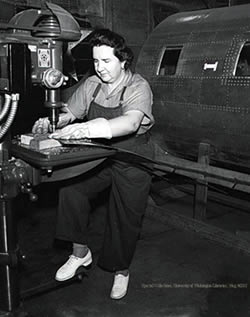 Still another group experienced considerable change to its status, beginning during the war. The shortage of male workers during wartime led to the large-scale recruitment of women into the workforce. At its peak the construction, the Hanford Camp contained about 4,350 women (and still more worked on the project who resided elsewhere). The Boeing Airplane Company employed about 55,000 people at peak production during the war, and almost half were women. Throughout the Puget Sound region, women comprised one-fourth of the industrial workforce, even though as late as 1939 they had been deemed incapable of handling many of the tasks to which they were now assigned. Most men and women regarded this work as temporary, and women customarily were both paid less than men for performing substantially the same kind of work and denied a chance to accrue seniority in the workplace. They also received little support for such domestic duties as daycare and shopping, which meant that women workers contributed more than their share to the high rates of absenteeism and job turnover during the war. Nonetheless, their wartime experience made a lasting imprint. After the numbers of women in the workplace shrunk through 1946 and into 1947 around the country, they began to rise again, and have kept rising ever since. In this respect, too, the Second World War initiated profound changes in the Pacific Northwest. [On women workers in the Northwest during the war, see Karen Anderson, Wartime Women: Sex Roles, Family Relations, and the Status of Women during World War II (Westport, Conn.: Greenwood Press, 1981), and Amy Kesselman, Fleeting Opportunities: Women Shipyard Workers in Portland and Vancouver during World War II and Reconversion (Albany: State University of New York Press, 1990).]
Still another group experienced considerable change to its status, beginning during the war. The shortage of male workers during wartime led to the large-scale recruitment of women into the workforce. At its peak the construction, the Hanford Camp contained about 4,350 women (and still more worked on the project who resided elsewhere). The Boeing Airplane Company employed about 55,000 people at peak production during the war, and almost half were women. Throughout the Puget Sound region, women comprised one-fourth of the industrial workforce, even though as late as 1939 they had been deemed incapable of handling many of the tasks to which they were now assigned. Most men and women regarded this work as temporary, and women customarily were both paid less than men for performing substantially the same kind of work and denied a chance to accrue seniority in the workplace. They also received little support for such domestic duties as daycare and shopping, which meant that women workers contributed more than their share to the high rates of absenteeism and job turnover during the war. Nonetheless, their wartime experience made a lasting imprint. After the numbers of women in the workplace shrunk through 1946 and into 1947 around the country, they began to rise again, and have kept rising ever since. In this respect, too, the Second World War initiated profound changes in the Pacific Northwest. [On women workers in the Northwest during the war, see Karen Anderson, Wartime Women: Sex Roles, Family Relations, and the Status of Women during World War II (Westport, Conn.: Greenwood Press, 1981), and Amy Kesselman, Fleeting Opportunities: Women Shipyard Workers in Portland and Vancouver during World War II and Reconversion (Albany: State University of New York Press, 1990).]
| Course Home | Previous Lesson | Next Lesson |